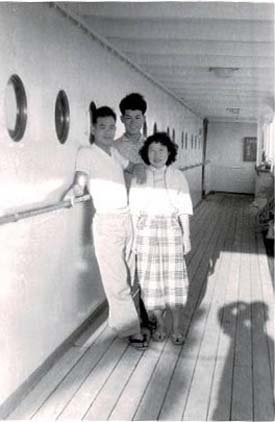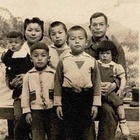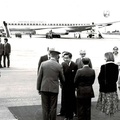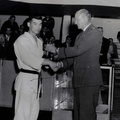After a two-week voyage, he arrived in San Pedro, Los Angeles. He was picked up in a car and arrived in Denver in June 1956. After staying with his father's friend for about a week, Toshiyuki became a schoolboy in a white American's house. A schoolboy was a live-in housekeeper-like job that was often done by Japanese immigrant students in the past. The student rented a room in an American's house, did housework such as washing dishes, cleaning, babysitting, and cooking, and received a small wage while attending school.
His cousin Kenichiro, the son of his father's older brother, was also working as a schoolboy in the neighborhood where Toshiyuki worked. Kenichiro was a classmate of Toshiyuki's in Tsunuki and had also returned to the United States.
"When I sent him a letter saying I was going to America, to Denver, he said, 'I'm currently doing judo. If you're coming to Denver, buy me a judo uniform and bring it with you.' Up until that point I'd been swimming in high school, but I'd never done judo. But when I saw the judo club members practicing, I thought it looked interesting, so I thought if I brought a judo uniform with me, I'd be able to practice with them."
That was Toshiyuki's first encounter with judo. "A second generation Japanese person was running the Denver dojo. It was quite a large place, and there were a lot of Japanese people there. There were also white people attending, and I think there were about 40 to 50 people in total who attended the dojo."
However, my life in Denver didn't last very long. After about three months, I realized that I couldn't live in Denver for long, so I contacted my older brother who had been living in Los Angeles for a year and told him that I wanted to go there. Then, the schoolboy company he was working at said, "You can take my place, so come here." Not only my older brother, but also my cousins on both my father's and mother's sides, as well as my uncles and aunts, had already returned to Los Angeles, and the men were making a living by gardening and the women by working in canning factories or sewing.
Returning to Los Angeles in October 1956, Toshiyuki began working as a schoolboy for a white family in Los Philly where his brother worked, cleaning the house, the pool, and the cars. "There was another Japanese woman employed at the family as a cook, and she happened to be my high school classmate in Kobe. I asked her, 'Hey, what are you doing here?'"
This was not the only chance encounter he had in Los Angeles. While working there, Toshiyuki attended an English school in Downtown Los Angeles to learn English. The majority of the students at the school, called Cambria, were Japanese or Japanese-American, with the rest being Latino. "Midori's brother was also there."
When I asked her if her brother had also returned to the United States, Midori answered, "He wasn't a resident, but my father's cousin's family immigrated to the United States and would occasionally visit Japan, so my brother went to study abroad in the United States after graduating from high school." He also went to school as a schoolboy and attended Pasadena City College.
"Actually, when my cousin arrived from Japan and I went to pick her up at the port, there was a man wearing a typically Japanese suit there. So when I went to the English school, I saw that same man. When we started talking, he said, 'That's how we arrived.' It turned out to be Midori's brother."
There was another coincidence. Takaya Norihiko, a classmate of his brother at Funairi High School in Hiroshima, was also studying abroad and attended Belmont High School. The three hit it off and played together so often that they were called the "Three Musketeers." Incidentally, Takaya Norihiko is the current owner of a safety hardware store in Little Tokyo.
Then, Norihiko, who knew that Toshiyuki was a judo player, introduced him to the Hollywood Dojo in Silver Lake, Los Angeles. This was in January 1957. Toshiyuki decided to start judo there, so he quit his job as a schoolboy, which was far from the dojo, and moved to a boarding house with meals nearby. He also started working part-time as a helper to the elderly gardener who lived in the boarding house, but his monthly salary was almost the same as the dojo's monthly tuition of $15. However, within a month of starting to attend, the dojo teacher waived his monthly tuition in exchange for him cleaning the dojo after practice, so he no longer had to find the money to pay the monthly tuition.
"There were several Japanese exchange students my age at the Hollywood dojo. I think they were also going to school or playing schoolboys, but they had some time after the dojo finished at 9 o'clock, so they decided to stay and practice. I had just started playing schoolboys in Hollywood at that time, so I would practice until 10:30, when the last bus left."
After much practice, Toshiyuki placed third in the lightweight class at a match in Los Angeles in 1958. The top three finishers were originally scheduled to compete in the U.S. National Championships in San Francisco, but unfortunately, as he had only recently begun judo, he was left out. However, the following year in 1959, he placed third again in the lightweight class in Los Angeles, and represented Southern California at the U.S. National Championships in San Jose, placing third in the 70kg class. The encounter he had at that tournament marked the beginning of a major change in Toshiyuki's life.
© 2022 Masako Miki







